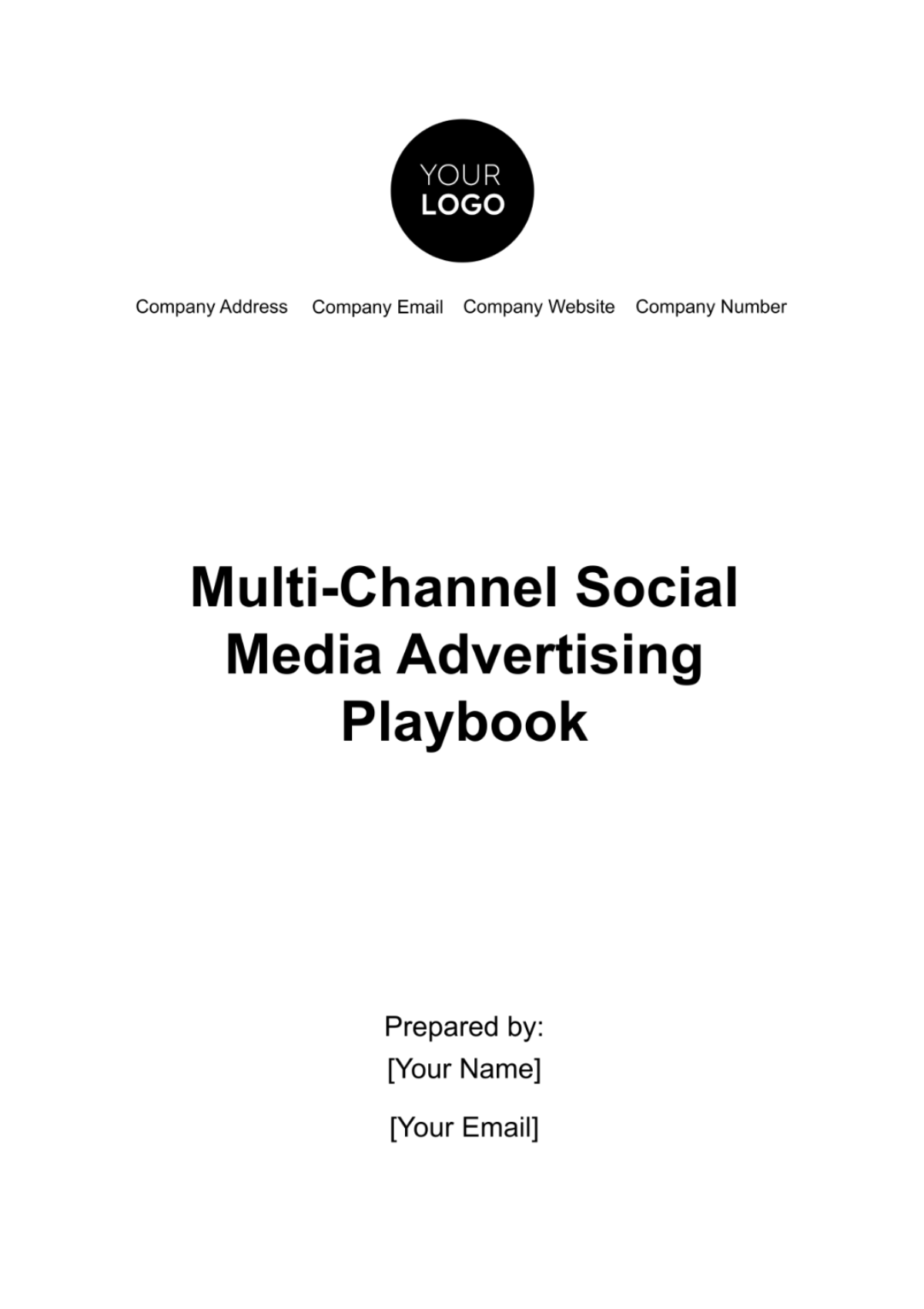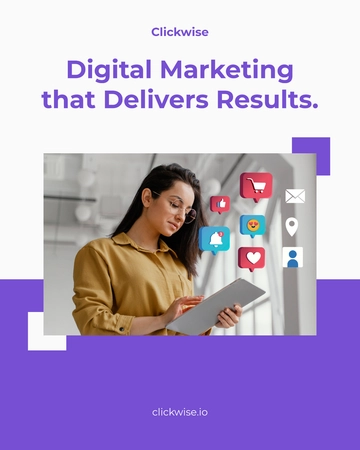Free Multi-Channel Social Media Advertising Playbook

I. Introduction
The playbook's purpose is to guide digital marketers and advertisers in going through the multi-channel campaigns, creating a nuanced understanding of the interconnected realms of social media.
Highlighting the significance of a multi-channel approach, we underline the power of synergy across diverse platforms. By intertwining the strengths of each channel, organizations can amplify their reach, engage varied audience segments, and achieve integrated campaign objectives.
II. Campaign Objectives
Defining Clear And Measurable Goals
Clearly articulate the purpose and desired outcomes of the advertising campaign. Establish specific, measurable, achievable, relevant, and time-bound (SMART) objectives to guide the strategic direction.
Aligning Objectives With Business Strategy
Ensure synergy between campaign goals and broader business objectives. Aligning advertising efforts with the overall business strategy enhances coherence and reinforces the campaign's contribution to organizational success.
Key Performance Indicators (KPIs)
Identify and prioritize key performance indicators that quantifiably measure success. From engagement rates to conversion metrics, selecting the right KPIs facilitates robust monitoring and evaluation throughout the campaign lifecycle.
III. Target Audience Profiling
Demographics And Psychographics
In this section, we will go through the essential task of understanding our audience, combining demographic and psychographic insights to create a durable profile. Demographics provide the basic framework, including age, gender, location, and occupation. Simultaneously, psychographics explore deeper aspects such as interests, values, and lifestyle choices.
Demographic And Psychographic Profile
Demographics | Psychographics |
Age | Interests and Hobbies |
Gender | Values and Beliefs |
Location | Lifestyle Choices |
Occupation | Personality Traits |
Behavioral Characteristics
Behavioral characteristics are important in refining our understanding of the target audience. This involves studying online behaviors, preferences, and interaction patterns. A comprehensive analysis of how our audience engages with content on each social media platform guides the tailoring of advertisements to align seamlessly with their online habits.
Platform-Specific Targeting
Recognizing that each social media platform caters to distinct user behaviors, preferences, and demographics, we further refine our targeting. This involves aligning our audience profile with the unique attributes of each chosen platform. The goal is to ensure our content resonates effectively, maximizing engagement and conversion potential.
IV. Platform Selection Strategy
Analysis Of Social Media Platforms
Conduct a thorough examination of available social media platforms, evaluating their unique features, user demographics, and advertising capabilities. This analysis aims to identify platforms aligning most closely with the campaign objectives.
Platform Suitability Matrix
Create a comprehensive grid outlining the suitability of each platform based on key criteria, such as target audience alignment, content format compatibility, and ad targeting options. This grid serves as a practical tool for informed decision-making.
Cross-Channel Integration
Explore opportunities for seamless integration across chosen platforms. Emphasize a cohesive brand presence while leveraging the strengths of each channel. This section provides guidelines for optimizing cross-channel strategies to amplify campaign impact.
V. Content Strategy
Crafting Compelling Visuals
In this section, we delve into the art of visual storytelling. Learn how to create captivating graphics and images that resonate with your audience across various social media platforms. Explore design principles, color psychology, and the optimal use of imagery to enhance brand messaging.
Copywriting Guidelines
Master the art of persuasive communication through effective copywriting. Understand the nuances of crafting compelling ad copy that not only grabs attention but also drives engagement and conversions. This section provides actionable tips and examples for creating impactful written content.
Message Consistency Across Channels
Consistency is key to brand success. Explore the importance of maintaining a unified brand voice and message across different social media channels. Learn how to adapt content for each platform while ensuring a cohesive narrative that reinforces brand identity.
VI. Budget Allocation And Resource Planning
Determining Advertising Budget
In this section, we meticulously outline the process of establishing an effective advertising budget that aligns with the overall campaign goals. By considering the scope and objectives, we provide a structured approach to ensure optimal resource allocation.
Key Points:
Conduct a thorough analysis of the campaign's objectives and the anticipated reach on each social media platform.
Utilize historical data and industry benchmarks to inform budgetary decisions, allowing for a realistic and goal-driven financial plan.
Resource Allocation For Each Channel
This segment delves into the nuanced process of allocating resources across chosen social media channels. By implementing a strategic approach, we guide the reader through the steps of optimizing resource allocation for maximum impact.
Key Components:
Present a resource allocation grid for a visual representation of the budget distribution among different channels.
Discuss the importance of aligning resource allocation with the specific characteristics and strengths of each platform.
ROI Considerations
In this critical subsection, we emphasize the significance of Return on Investment (ROI) in the context of budget allocation. Through practical insights, we guide the reader in evaluating the effectiveness of the campaign in relation to the allocated resources.
Key Considerations:
Introduce a structured framework for measuring and analyzing ROI, enabling data-driven decision-making.
Illustrate the importance of ongoing monitoring and adjustments to ensure optimal ROI throughout the campaign lifecycle.
VII. Ad Formats And Specifications
This section outlines the diverse landscape of ad formats and their respective specifications across selected social media platforms. Careful consideration of these elements is imperative for ensuring optimal visibility and engagement. Key components include:
Platform-Specific Ad Formats
In-depth analysis of ad formats offered by each platform.
Insights into the strengths and limitations of formats such as image ads, video ads, carousel ads, and sponsored posts.
Technical Requirements
Detailed specifications for images, videos, and other media assets.
Guidance on file formats, dimensions, and file size to meet platform standards.
Design Best Practices
Recommendations for creating visually compelling content.
Strategies for maintaining brand consistency while adhering to the unique requirements of each platform.
Understanding and implementing these guidelines ensures that advertisements resonate effectively with the audience while adhering to the technical intricacies of each social media channel.
VIII. Ad Scheduling And Timing
Identifying Peak Engagement Times
Understanding the optimal times for engaging the target audience is greatly important for campaign success. Conduct a thorough analysis of historical data and platform insights to pinpoint peak engagement periods on each social media channel.
Time Zone Considerations
Account for the geographical distribution of the target audience by incorporating time zone considerations. Implement a coherent schedule that aligns with peak engagement times across different regions, ensuring global reach and resonance.
Campaign Duration And Frequency
Carefully determine the ideal duration for the advertising campaign, balancing frequency and continuity. Establish a campaign timeline that maximizes exposure without overwhelming the audience. Utilize the following table as a guide for scheduling:
Social Media Platform | Peak Engagement Time (Local Time) | Recommended Frequency | Campaign Duration |
1:00 PM - 3:00 PM | 2 per day | 4 weeks | |
7:00 PM - 9:00 PM | 1 per day | 3 weeks | |
12:00 PM - 2:00 PM | 3 per day | 2 weeks | |
10:00 AM - 12:00 PM | 1 per day | 5 weeks |
Tailoring ad scheduling to align with peak engagement times and audience behaviors enhances visibility and interaction. Regularly monitor and adjust the schedule based on real-time analytics to optimize campaign performance.
IX. Monitoring And Analytics
Effective monitoring and analytics are pivotal for gauging the success of your multi-channel social media advertising campaign. This section outlines the key aspects of tracking and analyzing performance to derive actionable insights.
Key Metrics For Performance Evaluation
Identify and prioritize key performance indicators (KPIs) to measure the impact of your advertisements. Metrics such as engagement rates, click-through rates, and conversion rates provide valuable insights into campaign effectiveness.
Utilizing Analytics Tools
Select and implement strong and reliable analytics tools tailored to each social media platform. From comprehensive dashboards to platform-specific analytics, leverage these tools to gather real-time data on audience interactions, impressions, and other relevant metrics.
Data Interpretation And Iterative Optimization
Interpret the collected data to understand trends, user behavior, and areas for improvement. Use this information to iteratively optimize your campaign strategy. A continuous improvement cycle based on data-driven decisions ensures the adaptation of your campaign to evolving audience dynamics.
X. A/B Testing Framework
A/B testing is a pivotal component of our strategy, allowing us to experiment and optimize ad performance systematically. In this section, we delve into the significance of A/B testing, identifying key elements for experimentation, and establishing an iterative optimization process.
Importance Of A/B Testing
A/B testing, also known as split testing, empowers us to compare two or more variations of an ad element to determine which resonates most effectively with our audience. By systematically testing different creative elements, messaging, or targeting strategies, we can refine our approach based on data-driven insights.
Testable Elements In Advertisements
We outline specific elements suitable for A/B testing, including visuals, ad copy, calls-to-action, and audience targeting parameters. This comprehensive list enables us to strategically experiment with diverse facets of our advertisements, identifying the most impactful combinations.
Iterative Optimization
The A/B testing framework is not a one-time endeavor but a continuous process of refinement. We establish a structured approach to analyze test results, implement successful variations, and iteratively optimize our campaigns. This iterative methodology ensures that our advertising efforts evolve in alignment with changing audience preferences and market dynamics.
XI. Legal And Compliance Considerations
Navigating through legal and compliance considerations is critical in ensuring the ethical and lawful execution of multi-channel social media advertising campaigns. This section addresses the following key aspects:
Advertising Regulations Overview
Understand the legal framework governing advertising practices, encompassing regional and platform-specific regulations. Stay informed about restrictions, disclosure requirements, and prohibited content to maintain campaign legality and credibility.
Privacy And Data Protection Compliance
Prioritize user privacy by adhering to data protection regulations such as GDPR or CCPA. Clearly communicate data usage policies, obtain necessary consents, and implement robust security measures to safeguard user information.
Necessary Disclosures And Disclaimers
Articulate transparent and concise disclosures in advertisements where required. Ensure that disclaimers regarding product claims, promotions, or potential risks are prominently featured, aligning with industry standards and legal mandates.
Comprehensive adherence to legal and compliance considerations not only mitigates potential risks but also reinforces the campaign's integrity, fostering trust among the audience and regulatory authorities.
XII. Crisis Response Plan
In the unforeseen event of a crisis or the emergence of negative sentiments on social media, a well-prepared Crisis Response Plan is imperative. This section outlines a systematic approach to identify, address, and mitigate potential issues swiftly and effectively.
Identifying Potential Crisis Scenarios
To proactively manage crises, we identify potential scenarios that may arise, considering factors such as customer feedback, public opinion, and industry developments. By anticipating challenges, we can respond promptly and minimize the impact on our brand reputation.
Communication Strategies
Crafting effective communication is paramount during a crisis. This involves transparent and empathetic messaging tailored to the specific situation. The Crisis Response Plan provides guidelines on how to convey information, address concerns, and maintain a consistent brand voice across all communication channels.
Steps For Mitigation And Resolution
This section details a step-by-step process for mitigating the impact of a crisis. It includes collaboration with relevant teams, utilizing predefined response templates, and deploying resources strategically. The goal is to resolve issues swiftly while demonstrating a commitment to transparency, accountability, and customer satisfaction.
A well-executed Crisis Response Plan is integral to maintaining brand integrity and customer trust during challenging times. Regular reviews and simulations ensure that the plan remains current and effective in addressing evolving threats and concerns.
XIII. Conclusion
This playbook covers the strategic blueprint for creating successful multi-channel social media advertising campaigns. By revisiting the key strategies outlined throughout the document, we reinforce the importance of a meticulous and complete approach to achieve campaign objectives. Emphasizing a commitment to continuous improvement and adaptation, we encourage stakeholders to leverage insights gained from analytics, feedback loops, and emerging trends.
- 100% Customizable, free editor
- Access 1 Million+ Templates, photo’s & graphics
- Download or share as a template
- Click and replace photos, graphics, text, backgrounds
- Resize, crop, AI write & more
- Access advanced editor
Elevate your social media advertising game with Template.net's Multi-Channel Social Media Advertising Playbook Template. This comprehensive resource, editable and customizable, guides you through creating effective campaigns across multiple platforms. With our intuitive Ai Editor Tool, craft strategies tailored to each channel, maximizing your reach and engagement effortlessly.
You may also like
- Instagram Ad
- Instagram Banner
- Instagram Frame
- Instagram Post
- Instagram Profile Picture
- Instagram Story
- Instagram Story Highlights
- Twitter Ad
- Twitter Header
- Twitter Post
- LinkedIn Photo
- Linkedin Post
- YouTube
- Youtube Ad
- Youtube Banner
- YouTube Channel Art
- YouTube End Screen
- Youtube Profile Photo
- YouTube Thumbnail
- Facebook Ad
- Facebook Cover
- Facebook Post
- Facebook Profile Frame
- Facebook Profile Photo
- Twitch Offline Banner
- Linkedin Banner
- Twitch Overlay
- Whatsapp Status
- Reddit Banner
- Social Media Banner
- Social Media Clipart
- Social Media Plan
- Social Media Contract
- Social Media Planner
- Social Media Report
- Social Media Agreement
- Social Media Business Card
- Social Media Proposal
- Social Media Presentation





























